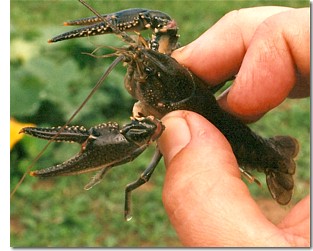
The Northern Crayfish - our Little Lobsters! |
By Doug Collicutt |
We had ventured back to one of my childhood stomping grounds, Omand's Creek in Winnipeg's West End, to catch some fish to raise in an aquarium. I had stretched a small seine net across a rocky section of the creek, just 100 metres or so from the creek's mouth at the Assiniboine River. I was going to do a "kick-seine", whereby I head upstream a few yards of the net, enter the water and kick up the rocks and creek bottom with my rubber boots dislodging any small fish from their hiding places and letting the current carry them down into my net. At least, that was the plan.
I had stepped into the creek, near some promising-looking rocks, already "counting my fish before they were in the net" and anticipating being a "cool Dad" for pulling off what I said I would do, actually catching some fish from this seemingly lifeless creek. I shuffled toward a medium sized boulder, stuck the toe of my boot along side it and applied some force to lift it. But, like an iceberg, there was more to the rock than met my eye. In accordance with Newton's Laws, my effort, intended to move the rock forward, resulted in moving me backward. With all the athleticism I could muster, I flailed my arms and shot my other leg backward, groping with it for a firm footing. Alas, "firm footing" and "creek bed" are two terms you don't often hear in one sentence. Down I went, on all fours. As the muddied, by me, water sloshed into my boots and soaked my pant legs and shirt sleeves, I retained the presence of mind to react to a flash of movement in the water, which was now rather close to my face. I stabbed at the movement and grabbed my hand shut around a large male crayfish. I could tell it was a male by the size and colour of the large pincers which quickly clamped onto the soft skin between my thumb and index finger.
 Despite the additional
slipping and flailing that were required to remove myself from the creek,
I was elated with my catch, even though who had whom was now in some
doubt! With the organic smell of creek bottom now permeating the air
around me, I hurriedly stuck my hand into the already filled (ready
for fish!) pail of water at hand and was rewarded with a quick release
from pain as the crayfish let go and scuttled around tying to flee.
There's a lesson for anyone unfortunate enough to get on the wrong
end of a crayfish. They pinch only as a last ditch effort in self defense.
If given the chance to flee, they will. So if you ever find yourself
in such a predicament as having a crayfish latched on to you, just stick
the affected part of your anatomy back into the water where the crayfish
will feel safer and swim away. This technique also works with snapping
turtles. Don't ask how I know!
Despite the additional
slipping and flailing that were required to remove myself from the creek,
I was elated with my catch, even though who had whom was now in some
doubt! With the organic smell of creek bottom now permeating the air
around me, I hurriedly stuck my hand into the already filled (ready
for fish!) pail of water at hand and was rewarded with a quick release
from pain as the crayfish let go and scuttled around tying to flee.
There's a lesson for anyone unfortunate enough to get on the wrong
end of a crayfish. They pinch only as a last ditch effort in self defense.
If given the chance to flee, they will. So if you ever find yourself
in such a predicament as having a crayfish latched on to you, just stick
the affected part of your anatomy back into the water where the crayfish
will feel safer and swim away. This technique also works with snapping
turtles. Don't ask how I know!
My youngest son peered into the pail. "Huh! What the heck is that!" were his words as he gazed upon Orconectes virilis, the Northern Crayfish, for the first time!
"That . . .", I expounded, "is a crayfish. It's like a little lobster."
"Cool, can we keep him?", was the response from my older son, who has a passion for putting critters into containers. (Wonder where he got that from?)
"Yeah, for a while", I answered. At least long enough for me to get enough pictures for an article!
Crayfish are
fairly common, but seldom seen critters. They haven't attracted
a lot of attention from local scientists and I wasn't able to
track down as much information about them as I would have liked.
If you have information or images that would help others to
better understand and appreciate our Northern Crayfish, please Email NatureNorth.com. |
Return to Fall Issue | NatureNorth Front Page

